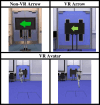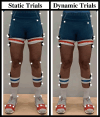Design, development and pilot of a realistic virtual reality application to analyse quick directional change in sport: Avatar cutting scenario with alterable parameters
- PMID: 40554489
- PMCID: PMC12186900
- DOI: 10.1371/journal.pone.0324941
Design, development and pilot of a realistic virtual reality application to analyse quick directional change in sport: Avatar cutting scenario with alterable parameters
Abstract
Injuries during quick directional change (cutting) are common, particularly to the anterior cruciate ligament of the knee. Cutting is subsequently a focus in research and clinical practices. However, it is usually assessed in situations with low ecological validity. As a solution, virtual reality (VR) has been used to replicate sporting scenarios. The current paper details the design, development, and piloting of a VR application based on an unanticipated-cutting scenario using an avatar-opponent blocking manoeuvre. The VR environment is highly realistic, avatar approach is instigated by the movement of the headset user, and simple input alters the avatar's movements and spatiotemporal demands of the cutting task. Piloting occurred in two stages: the first involved three participants and focused on initial system testing and parameter optimisation, the second focused on a pilot case study with a female participant of typical population. The case study evaluated the effects of using different visual cutting cues on frontal plane knee kinematics and kinetics linked to injury risk. Twenty-five successful, unanticipated, 90⁰ cutting manoeuvres to the left were analysed in three conditions: 1) physical world with arrows, 2) VR environment emulation with VR arrows, 3) VR environment emulation with VR avatar opponent. Mean knee angle during the arrow conditions, both physical and VR, presented abduction angles (-8.82° ± 1.44; -2.66° ± 0.90), yet cutting around the avatar opponent presented knee adduction angles (9.78° ± 0.44). During the 50 ms prior to heel strike, pelvis velocity was lowest and cutting foot velocity highest in the avatar condition compared to arrow conditions. This indicated the VR environment acts as a suitable control and that cutting strategy was adapted approaching the avatar, displaying more caution on approach. The avatar-based application has the potential to improve the ecological validity of cutting assessment and make a VR application more accessible to researchers and clinicians, with further development.
Copyright: © 2025 Tang et al. This is an open access article distributed under the terms of the Creative Commons Attribution License, which permits unrestricted use, distribution, and reproduction in any medium, provided the original author and source are credited.
Conflict of interest statement
The authors have declared that no competing interests exist.
Figures









Similar articles
-
Virtual reality aggression assessment with social interaction: early evidence for validity from two pilot studies.Front Psychol. 2025 Jun 13;16:1585609. doi: 10.3389/fpsyg.2025.1585609. eCollection 2025. Front Psychol. 2025. PMID: 40584070 Free PMC article.
-
A rapid and systematic review of the clinical effectiveness and cost-effectiveness of topotecan for ovarian cancer.Health Technol Assess. 2001;5(28):1-110. doi: 10.3310/hta5280. Health Technol Assess. 2001. PMID: 11701100
-
Biomechanical fidelity of athletic training using virtual reality head-mounted display: the case of preplanned and unplanned sidestepping.Sports Biomech. 2025 Mar;24(3):672-693. doi: 10.1080/14763141.2022.2146528. Epub 2022 Nov 22. Sports Biomech. 2025. PMID: 36412262
-
Effects of virtual reality immersion on postural stability during a dynamic transition task.Sports Biomech. 2025 Apr;24(4):859-873. doi: 10.1080/14763141.2022.2162434. Epub 2023 Jan 4. Sports Biomech. 2025. PMID: 36597788 Free PMC article.
-
Signs and symptoms to determine if a patient presenting in primary care or hospital outpatient settings has COVID-19.Cochrane Database Syst Rev. 2022 May 20;5(5):CD013665. doi: 10.1002/14651858.CD013665.pub3. Cochrane Database Syst Rev. 2022. PMID: 35593186 Free PMC article.
References
-
- Chia L, De Oliveira Silva D, Whalan M, McKay MJ, Sullivan J, Fuller CW, et al. Non-contact Anterior Cruciate Ligament Injury Epidemiology in Team-Ball Sports: A Systematic Review with Meta-analysis by Sex, Age, Sport, Participation Level, and Exposure Type. Sports Med. 2022;52(10):2447–67. doi: 10.1007/s40279-022-01697-w - DOI - PMC - PubMed
-
- McBurnie AJ, Dos’Santos T. Multidirectional Speed in Youth Soccer Players: Theoretical Underpinnings. Strength Condition J. 2022;44(1):15–33. doi: 10.1519/ssc.0000000000000658 - DOI
-
- Dos’Santos T, McBurnie A, Thomas C, Jones PA, Harper D. Attacking Agility Actions: Match Play Contextual Applications With Coaching and Technique Guidelines. Strength Condition J. 2022;44(5):102–18. doi: 10.1519/ssc.0000000000000697 - DOI
MeSH terms
LinkOut - more resources
Full Text Sources
Research Materials

